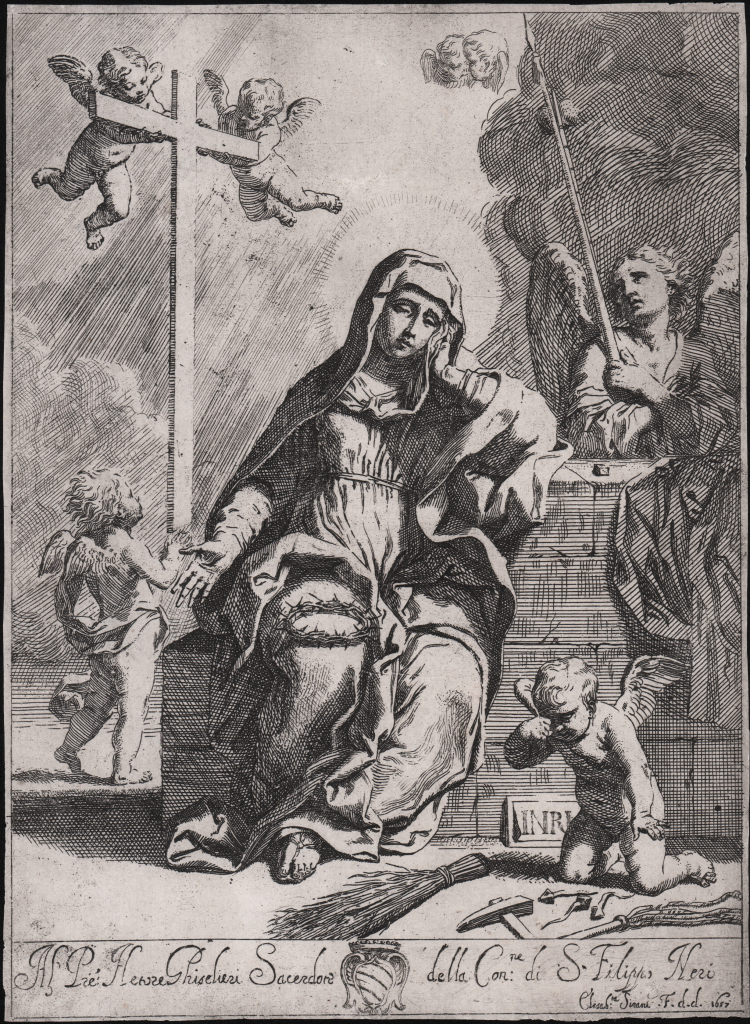




| Reference: | S47163 |
| Author | Elisabetta SIRANI |
| Year: | 1657 |
| Measures: | 200 x 275 mm |



| Reference: | S47163 |
| Author | Elisabetta SIRANI |
| Year: | 1657 |
| Measures: | 200 x 275 mm |
The Virgin of Sorrows, seated among angels holding the implements of Christ's passion.
Etching, 1657, with etched dedication to Etore Ghiselieri signed 'Elisab Sirani F d d 1657'.
Elisabetta Sirani has the distinction of being the earliest known female painter-engraver in Europe, and the only one whose prints have survived. Sirani was also the first female printmaker in her native city of Bologna. She created ten etchings, all of religious subjects, across her career. Malvasia, who collected Sirani’s prints, records that she etched only infrequently as a pastime, and the small number of surviving etchings speaks to the fact that this was a minor part of her production. However few prints she produced, it is evident that Sirani was as skilled with an etching needle as she was with a brush.
The present etching records Sirani’s painting of the Madonna of Sorrows with Symbols of the Passion, an early work on copper from 1657 that depicts the Virgin and angels mourning the death of Christ. This painting, one of Sirani’s most impressive and best known private devotional works, was made for Padre Ettore Ghisilieri, a priest at the Church of the Madonna di Galliera and one of Sirani’s most important early patrons. Before joining a religious order, Ghisilieri founded a life drawing academy at his palazzo, which was run by Elisabetta’s father—an association that would lead to several commissions from the young artist. Ghisilieri kept these paintings by Elisabetta in his private apartments in the Oratory attached to the church. A preparatory drawing for the painting, which served as the basis for the print but differs in dimensions and shows no signs of transfer, is in the Staatsgalerie, Stuttgart.
Sirani produced the etching as a presentation print for her patron, to whom it is dedicated: “Al Pre’ Hetore Ghisilieri Sacerdote della Con.ne di .S. Filippo Neri” (To the Prior Ettore Ghisilieri Priest at the Congregation of San Filippo Neri). She also proudly signed it “Elisab:ta Sirani .F. d.d.”. This etching was clearly a work of significance to the artist, as it was one of only two prints that she recorded making. Her 1657 work book entry describes the painting and the etching together: “For Father Ettore Ghisilieri, priest at the Madonna di Galliera, a copper [painting] with the Blessed Virgin contemplating the crown of thorns, and various small Angels contemplating other instruments of the Passion, and I also incised it in copperplate”.
A very good impression on contemporary laid paper, trimmed to the platemark, in good condition.
Bibliografia
Bartsch / Le Peintre graveur (XIX.155.7); Adelina Modesti, “Alcune riflessioni sulle opere grafiche della pittrice Elisabetta Sirani nelle raccolte dell’Archiginnasio,” L’Archiginnasio, vol. 96 (2001), pp. 162-164, fig. 8.
Elisabetta SIRANI (Bologna 1628 – 1665)
|
Italian painter. She was the daughter of Giovanni Andrea Sirani (1610–70), who had been Guido Reni’s principal assistant. Encouraged by Carlo Malvasia, her mentor and eventual biographer, she was painting professionally by the age of 17. Her prolific talent, as well as her reputed beauty and modesty, soon brought her European renown. The details of her training are unclear, but as a woman she would not have had access to an academy and (like many other professional women painters prior to the 20th century) she was probably taught by her father. Her sisters Anna Maria (1645–1715) and Barbara (alive in 1678) were also practising artists and Elisabetta herself is known to have had female students. As women, they could not undertake any formal study of the male nude, and Sirani’s weakness in depicting male anatomy is sometimes clearly detectable in her work (e.g. St Jerome in the Wilderness, 1650; Bologna, Pin. N.). Sirani’s drawings employ a highly individual pen-and-wash method, eschewing outline and employing quick, blunt strokes of barely dilute ink to create striking chiaroscuro effects. Her painting style is less distinctive, her fierce chiaroscuro softened by the rich brown shadows favoured by her generation of Bolognese painters.
|
Elisabetta SIRANI (Bologna 1628 – 1665)
|
Italian painter. She was the daughter of Giovanni Andrea Sirani (1610–70), who had been Guido Reni’s principal assistant. Encouraged by Carlo Malvasia, her mentor and eventual biographer, she was painting professionally by the age of 17. Her prolific talent, as well as her reputed beauty and modesty, soon brought her European renown. The details of her training are unclear, but as a woman she would not have had access to an academy and (like many other professional women painters prior to the 20th century) she was probably taught by her father. Her sisters Anna Maria (1645–1715) and Barbara (alive in 1678) were also practising artists and Elisabetta herself is known to have had female students. As women, they could not undertake any formal study of the male nude, and Sirani’s weakness in depicting male anatomy is sometimes clearly detectable in her work (e.g. St Jerome in the Wilderness, 1650; Bologna, Pin. N.). Sirani’s drawings employ a highly individual pen-and-wash method, eschewing outline and employing quick, blunt strokes of barely dilute ink to create striking chiaroscuro effects. Her painting style is less distinctive, her fierce chiaroscuro softened by the rich brown shadows favoured by her generation of Bolognese painters.
|